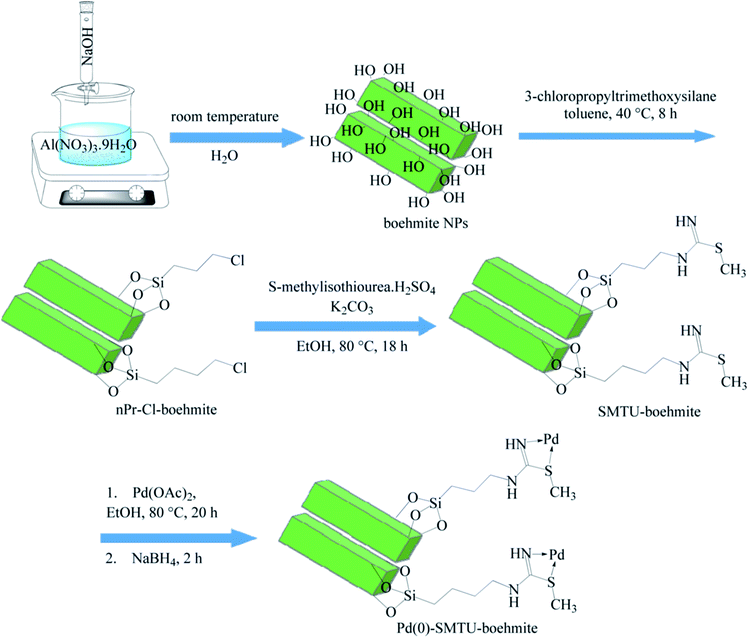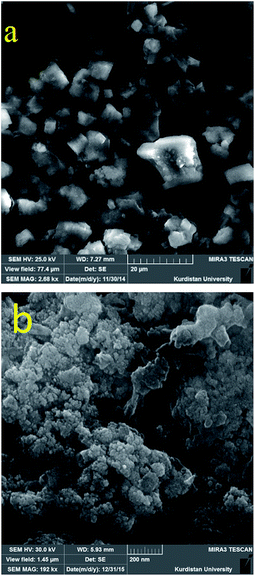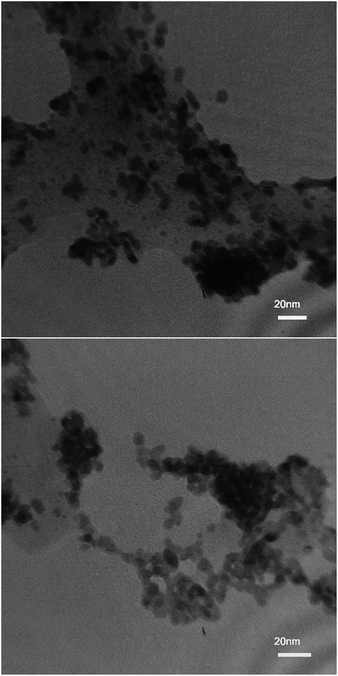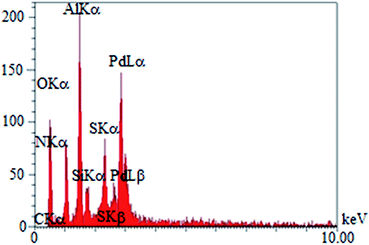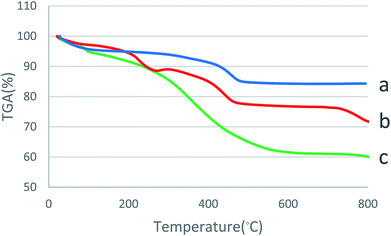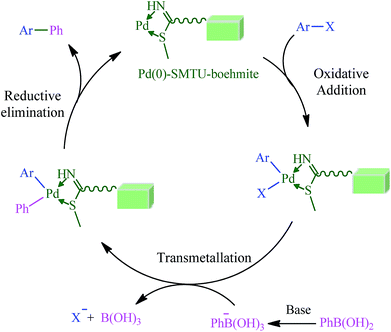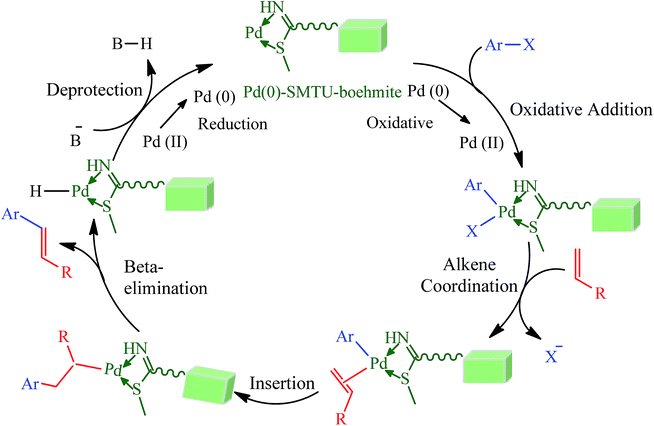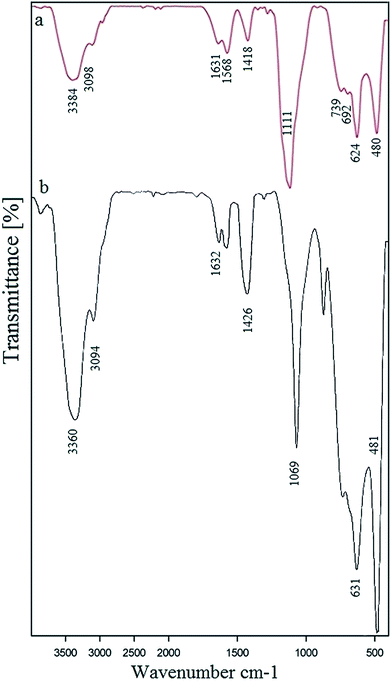Synthesis of a new Pd(0)-complex supported on boehmite nanoparticles and study of its catalytic activity for Suzuki and Heck reactions in H2O or PEG
Arash Ghorbani-Choghamarani*,
Bahman Tahmasbi and
Parisa Moradi
Department of Chemistry, Faculty of Science, Ilam University, P. O. Box 69315516, Ilam, Iran. E-mail: arashghch58@yahoo.com; a.ghorbani@mail.ilam.ac.ir; Fax: +98 841 2227022; Tel: +98 841 2227022
First published on 15th April 2016
Abstract
Boehmite nanoparticles are a cubic orthorhombic structure of aluminum oxide hydroxide containing hydroxyl groups attached to their surface, which were prepared in water using commercially available materials. A moisture- and air-stable palladium S-methylisothiourea complex supported on boehmite nanoparticles (Pd(0)–SMTU–boehmite) was prepared using a very simple and inexpensive procedure without an inert atmosphere using commercially available materials. This nanostructure compound was used as an excellent organometallic catalyst for Suzuki and Heck reactions in H2O or PEG-400. The synthesized nanoparticles were characterized using FT-IR, XRD, BET, TGA, TEM, SEM, EDS and ICP-OES techniques. Nitrogen adsorption/desorption measurements indicated that the boehmite nanoparticles have a BET surface area of about 122.8 m2 g−1. This heterogeneous nanocatalyst was easily separated from the reaction mixture and reused for several consecutive runs without significant loss of its catalytic efficiency or palladium leaching. The leaching of palladium from the catalyst was examined using hot filtration and ICP-OES techniques.
1 Introduction
Boehmite consists of aluminum oxide hydroxide (γ-AlOOH) particles, and the surface of boehmite nanoparticles is covered with hydroxyl groups. The boehmite structure consists of double sheets of octahedral units with aluminum ions at their centers and the sheets themselves are composed of octahedral chains, and boehmite has a cubic orthorhombic structure. Also, boehmite nanoparticles are not moisture- or air-sensitive, and have been synthesized in H2O at room temperature without an inert atmosphere using available materials such as Al(NO3)3·9H2O and NaOH. Boehmite has important applications in the preparation of catalysts for petrochemical and petroleum refining processes.1 Boehmite is an important precursor material for the preparation of ceramic membranes and coatings.1–3 Boehmite is also used for building units and as a directing template in the preparation of core–shell materials,2 which have been extensively used in catalysts, optical materials, cosmetic products, vaccine adjuvants and pillared clays, and for sweep-flocculation in fresh water treatment and as an adsorbent,2–4 due to their unique properties such as good porosity and thermal stability, and a high specific surface area (>120 m2 g−1).5,6 Another important application of boehmite is producing α-Al2O3 by calcination at high temperatures.6 Furthermore, boehmite has excellent properties such as chemical resistance, good mechanical strength, good conductivity, high hardness, transparency, low cost, high abrasion and corrosion resistance, excellent biocompatibility and a controllable synthesis.7,8 The chemical and physical properties of boehmite nanoparticles are very dependent on the experimental factors of their synthesis, such as the nature of the Al(III)-salt, pH, temperature, time of aging etc. Therefore, numerous methods have been reported for the preparation of boehmite nanoparticles such as hydrothermal (HS),9 sol–gel,10 and hydrolysis of aluminum11 methods. Also the effect of temperature, ultrasonic waves, time and the Al/OH molar ratio on the synthesis of boehmite has been studied by L. Rajabi et al.4 Despite several studies on the morphology, properties and preparation of boehmite, there are few reports on the modification of nano-boehmite surfaces that have been reported as heterogeneous catalysts.12–14 Therefore, an attempt has been made to modify the surface of boehmite nanoparticles in this work. In this regard, a palladium S-methylisothiourea complex has been supported on the boehmite nanoparticles and applied as an excellent and reusable nano-organometallic catalyst for C–C coupling reactions, because cross-coupling reactions have been used as a powerful method in modern synthetic organic chemistry for the preparation of natural products, advanced materials, agrochemicals, pharmaceuticals, herbicides, biologically active compounds, polymers, UV screens, hydrocarbons and liquid crystal materials.15–192 Results and discussion
2.1 Catalyst preparation
In a continuation of our studies on the application of immobilized metal complexes on boehmite nanoparticles in organic reactions,3,12 herein, we report the preparation and characterization of a Pd(0) complex supported on boehmite nanoparticles. Initially, the nano-boehmite was prepared via addition of NaOH to a solution of Al(NO3)3·9H2O as the source of aluminum at room temperature. Subsequently, the boehmite nanoparticles were modified with 3-chloropropyltrimethoxysilane (CPTMS), then grafting of S-methylisothiourea (SMTU) on the prepared nPr–Cl–boehmite provided the S-methylisothiourea-functionalized boehmite nanoparticles (SMTU–boehmite). Finally, Pd nanoparticles were supported on SMTU–boehmite (Pd(0)–SMTU–boehmite) using a concise route that is outlined in Scheme 1.2.2 Catalyst characterization
The prepared nanoparticles were characterized using SEM, TEM, EDS, TGA, XRD, BET, FT-IR and ICP-OES techniques.The XRD patterns of the boehmite nanoparticles and Pd(0)–SMTU–boehmite are shown in Fig. 1. As can be seen in Fig. 1, the boehmite phase was characterized by peak positions at 2θ values of 14.40, 28.41, 38.55, 46.45, 49.55, 51.94, 56.02, 59.35, 65.04, 65.56, 68.09, and 72.38 in the XRD pattern, which could be attributed to (0 2 0), (1 2 0), (0 3 1), (1 3 1), (0 5 1), (2 0 0), (1 5 1), (0 8 0), (2 3 1), (0 0 2), (1 7 1), and (2 5 1) reflections, respectively. This XRD pattern of the boehmite nanoparticles conforms to the standard boehmite nanoparticle XRD spectrum and all the peaks confirmed the crystallization of boehmite with an orthorhombic unit cell.14,20 Also the XRD pattern of Pd(0)–SMTU–boehmite contains a series of peaks (39°, 46° and 67°) which are indexed to the Pd(0) on the surface of the boehmite,21–24 which overlap with (0 3 1), (1 3 1), (2 3 1), (0 0 2) and (1 7 1) reflections.
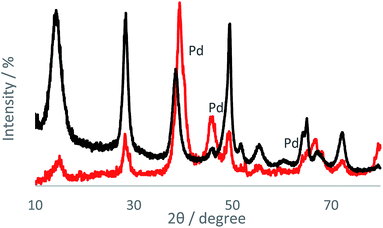 | ||
| Fig. 1 The XRD patterns of the boehmite nanoparticles (black line) and Pd(0)–SMTU–boehmite (red line). | ||
Fig. 2 shows the FT-IR spectra of the boehmite, nPr–Cl–boehmite, SMTU–boehmite and Pd(0)–SMTU–boehmite. The FT-IR spectrum of the boehmite nanoparticles (spectrum a) shows two strong bands at 3086 and 3308 cm−1, which are attributed to both the symmetrical and asymmetrical modes of the O–H bonds on the surface of the boehmite nanoparticles.3,14 In the FT-IR spectra a–d, several peaks that appear at 480, 605 and 735 cm−1 can be related to the absorption of Al–O bonds.12 Also, a nitrate impurity vibration at 1650 cm−1 and the vibrations of hydrogen bonds of OH⋯OH resulting in two strong absorption bands at 1164 and 1069 cm−1 were observed in the FT-IR spectra.3,4 In the FT-IR spectrum of nPr–Cl–boehmite (spectrum b), the presence of anchored chloropropyltrimethoxysilane was confirmed by C–H stretching vibrations that appear at 2955 cm−1 and also O–Si stretching vibration modes that appear at 1073 cm−1.26 In the FT-IR spectrum of SMTU–boehmite (spectrum c), the existence of grafted S-methylisothiourea groups was identified from C![[double bond, length as m-dash]](https://www.rsc.org/images/entities/char_e001.gif) N vibrations that appear at 1638 cm−1, and this band was shifted to lower frequency (1631 cm−1) in the catalyst spectrum (spectrum d), which indicates the formation of a palladium complex on the surface of the functionalized nano-boehmite.27
N vibrations that appear at 1638 cm−1, and this band was shifted to lower frequency (1631 cm−1) in the catalyst spectrum (spectrum d), which indicates the formation of a palladium complex on the surface of the functionalized nano-boehmite.27
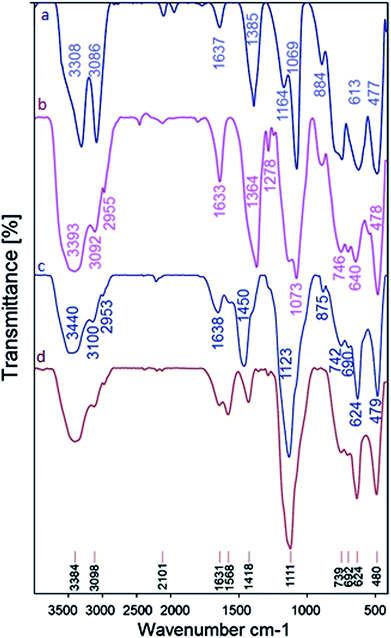 | ||
| Fig. 2 FT-IR spectra of (a) boehmite, (b) nPr–Cl–boehmite, (c) SMTU–boehmite and (d) Pd(0)–SMTU–boehmite. | ||
The orthorhombic structure of the boehmite nanoparticles was confirmed using SEM techniques (Fig. 3). TEM images (Fig. 4) revealed more accurate information on the morphology and particle size of the palladium nanoparticles. It can be seen that most of the palladium nanoparticles were of nanometer-size with an average diameter of about 5–10 nm.
In order to prove the presence of palladium metal on the surface of the functionalized boehmite, an EDS technique was applied. The EDS spectrum of Pd(0)–SMTU–boehmite is shown in Fig. 5. As shown in Fig. 5, the EDS spectrum of Pd(0)–SMTU–boehmite shows the presence of Al, O, Si, C, S, N and as well as Pd species in the Pd(0)–SMTU–boehmite. Also for quantitative analysis and to obtain the exact amount of palladium, ICP-OES was applied. According to the inductively coupled plasma (ICP) analysis, the exact amount of palladium in the heterogeneous catalyst was calculated to be 2.55 mmol g−1.
Nitrogen adsorption–desorption isotherms of the boehmite nanoparticles are shown in Fig. 6. The N2 physical adsorption and desorption isotherms were obtained at 120 °C to investigate the surface areas, and the Brunauer–Emmett–Teller (BET) surface area for the boehmite nanoparticles was obtained as 122.8 m2 g−1. When the Pd complex was loaded on the boehmite nanoparticles, the BET specific surface area decreased from 122.8 to 82.90 m2 g−1. As shown in Table 1, BET analysis of the boehmite nanoparticles provided a pore diameter of 1.64 nm and a pore volume of 0.22 cm3 g−1.
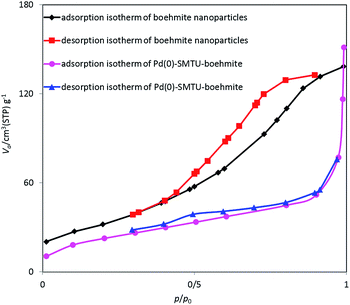 | ||
| Fig. 6 Nitrogen adsorption–desorption isotherms of the boehmite nanoparticles and Pd(0)–SMTU–boehmite. | ||
| Sample | SBET (m2 g−1) | Pore diam. by BJH method (nm) | Pore vol. (cm3 g−1) |
|---|---|---|---|
| Boehmite nanoparticles | 122.8 | 1.64 | 0.22 |
| Pd(0)–SMTU–boehmite | 82.90 | 1.21 | 0.19 |
The pore volume and pore diameter of Pd(0)–SMTU–boehmite are lower than for the boehmite nanoparticles. On the basis of these results, the successful grafting of organic groups as well as palladium to the boehmite nanoparticles was verified.
Fig. 7 shows the TGA analysis of the boehmite nanoparticles, SMTU–boehmite and Pd(0)–SMTU–boehmite. The TGA analysis data showed a 16% weight loss from 25–250 °C for the nano-boehmite, which is due to desorption of water and dehydration of the surface hydroxyl groups.25 The total mass loss for SMTU–boehmite was approximately 29% from 300–800 °C, which is attributed to the decomposition of immobilized organic moieties on the nano-boehmite surface. Meanwhile, a weight loss of about 40% from 250 to 800 °C occurred for Pd(0)–SMTU–boehmite. On the basis of these results, the successful grafting of organic groups as well as a palladium complex to the boehmite nanoparticles was verified.
The thermal stability of the Pd(0)–SMTU–boehmite was also considered. As shown in Fig. 7, this catalyst was stable even at 300 °C.
2.3 Catalytic activity of Pd(0)–SMTU–boehmite in the C–C coupling reactions
Cross-coupling reactions such as Suzuki and Heck reactions are powerful tools for the preparation of natural products, advanced materials, agrochemicals, pharmaceuticals and biologically active compounds.28–37 Therefore, we investigated the catalytic activity of Pd(0)–SMTU–boehmite as a new heterogeneous and highly reusable nanocatalyst for C–C couplings through the Suzuki reaction. For this purpose, the coupling of iodobenzene with phenylboronic acid was selected as a simple model reaction to establish the feasibility of the strategy and optimize the reaction conditions, and the results are summarized in Table 2. We examined the effect of different parameters (including the solvent, base, reaction temperature, and amount of Pd(0)–SMTU–boehmite) on the outcome of the C–C coupling reaction of iodobenzene with phenylboronic acid (Table 2). The catalyst is not thermal, air, or moisture sensitive, hence an inert atmosphere was not employed in any of the reactions. Interestingly, the reaction did not proceed in the absence of Pd(0)–SMTU–boehmite even after 6 hours (Table 2, entry 1). In order to choose the reaction medium, different solvents such as PEG, DMF, DMSO, H2O and ethanol were used (Table 1, entries 5–9), and the best result was obtained with H2O in the presence of 0.005 gr (0.8 mol%) of Pd(0)–SMTU–boehmite (Table 2, entry 14). Also, the effect of the nature and amount of the base used was studied, and inferior results were obtained using NaOEt, KOH, and Et3N (Table 1, entries 9–11). Excellent biphenyl yields were obtained using 1.5 mmol of sodium carbonate at room temperature. As shown in Table 2, iodobenzene (1 mmol) in the presence of a catalytic amount of Pd(0)–SMTU–boehmite (0.005 g, 0.8 mol%) and Na2CO3 (1.5 mmol) with phenylboronic acid (1 mmol) in H2O at room temperature was considered to be the ideal reaction conditions for the formation of the corresponding biphenyl.| Entry | Catalyst (mg) | Solvent | Base | Amount of base (mmol) | Temperature (°C) | Time (min) | Yielda (%) |
|---|---|---|---|---|---|---|---|
| a Isolated yield.b No reaction. | |||||||
| 1 | — | H2O | Na2CO3 | 3 | 80 | 360 | —b |
| 2 | 3 | H2O | Na2CO3 | 3 | 80 | 35 | 85 |
| 3 | 5 | H2O | Na2CO3 | 3 | 80 | 25 | 90 |
| 4 | 7 | H2O | Na2CO3 | 3 | 80 | 20 | 91 |
| 5 | 5 | PEG | Na2CO3 | 3 | 80 | 25 | 88 |
| 6 | 5 | EtOH | Na2CO3 | 3 | 80 | 25 | 70 |
| 7 | 5 | DMSO | Na2CO3 | 3 | 80 | 25 | 22 |
| 8 | 5 | DMF | Na2CO3 | 3 | 80 | 25 | 15 |
| 9 | 5 | H2O | NaOEt | 3 | 80 | 25 | 10 |
| 10 | 5 | H2O | Et3N | 3 | 80 | 25 | 15 |
| 11 | 5 | H2O | KOH | 3 | 80 | 25 | 32 |
| 12 | 5 | H2O | Na2CO3 | 1.5 | 80 | 30 | 90 |
| 13 | 5 | H2O | Na2CO3 | 1.5 | 60 | 40 | 93 |
| 14 | 5 | H2O | Na2CO3 | 1.5 | r.t. | 45 | 94 |
After the optimization of the reaction conditions, we examined the catalytic activity of Pd(0)–SMTU–boehmite for various substrates and the results are shown in Table 3. Various aryl iodides (Table 3, entries 1, 2 and 12), bromides (Table 3, entries 3–8, 13 and 14) and chlorides (Table 3, entries 9–11) were converted into the corresponding biphenyls. However, completion of the reaction involving chlorobenzene was slower than for iodobenzene or bromobenzene. The aryl halides including electron-donating and electron-withdrawing functional groups were successfully converted to the corresponding biphenyls in short reaction times with good to excellent yields (Table 3). Therefore, the experimental procedure is very simple and convenient, and has the ability to tolerate a variety of different functional groups such as OH, CN, NO2, alkyl and OCH3 under the reaction conditions.
| Entry | Aryl halide | Ar-B(OH)2 | Time (min) | Yielda (%) | Melting point (°C) | Reported melting point (°C) (ref.) |
|---|---|---|---|---|---|---|
| a Isolated yield. | ||||||
| 1 | Iodobenzene | C6H5B(OH)2 | 45 | 94 | 68 | 67–68 (ref. 17) |
| 2 | 4-Iodotoluene | C6H5B(OH)2 | 90 | 87 | 45–46 | 44–47 (ref. 17) |
| 3 | Bromobenzene | C6H5B(OH)2 | 90 | 92 | 66–68 | 67–68 (ref. 17) |
| 4 | 4-Bromotoluene | C6H5B(OH)2 | 180 | 85 | 44–46 | 44–47 (ref. 17) |
| 5 | 4-Bromobenzonitrile | C6H5B(OH)2 | 50 | 90 | 86–88 | 83 (ref. 21) |
| 6 | 4-Bromonitrobenzene | C6H5B(OH)2 | 25 | 99 | 110–113 | 111–113 (ref. 21) |
| 7 | 4-Bromophenol | C6H5B(OH)2 | 90 | 96 | 157–160 | 157–160 (ref. 21) |
| 8 | 4-Bromochlorobenzene | C6H5B(OH)2 | 90 | 98 | 69–71 | 70–71 (ref. 17) |
| 9 | Chlorobenzene | C6H5B(OH)2 | 185 | 93 | 67–69 | 67–68 (ref. 17) |
| 10 | 4-Chloronitrobenzene | C6H5B(OH)2 | 50 | 93 | 111–114 | 111–113 (ref. 21) |
| 11 | 4-Chlorobenzonitrile | C6H5B(OH)2 | 90 | 97 | 87–89 | 83 (ref. 21) |
| 12 | Iodobenzene | 3,4-diF-C6H3B(OH)2 | 360 | 89 | 39–41 | — |
| 13 | Bromobenzene | 3,4-diF-C6H3B(OH)2 | 420 | 91 | 40–42 | — |
| 14 | 4-Bromonitrobenzene | 3,4-diF-C6H3B(OH)2 | 390 | 98 | 119–120 | — |
We also applied the optimized reaction conditions to the coupling of aryl halides with 3,4-difluorophenylboronic acid. However, 3,4-difluorophenylboronic acid showed less reactivity toward the coupling reaction than unfunctionalized phenylboronic acid. Iodobenzene, bromobenzene and 4-nitrobromobenzene were reacted with 3,4-difluorophenylboronic acid and the corresponding cross-coupling products were obtained in reasonable yield (Table 3, entries 13–15). Therefore, these results reveal that this methodology is effective for a wide range of aryl halides and phenylboronic acid derivatives.
The catalytic cycle for this C–C bond formation reaction in the presence of Pd(0)–SMTU–boehmite is outlined in Scheme 2.38,39
In order to extend the catalytic applications of the Pd(0)–SMTU–boehmite, this catalyst was investigated for C–C coupling through the Heck reaction. The Pd(0)–SMTU–boehmite was tested as a heterogeneous catalyst in the cross-coupling of iodobenzene with butyl acrylate to ascertain the best conditions for the reaction. The effect of the solvent (DMF, DMSO, H2O, EtOH or PEG), temperature (room temperature to 120 °C), amount of catalyst, and the nature and amount of the base (Et3N, Na2CO3, KOH or NaOEt) on the outcome of the coupling of iodobenzene with butyl acrylate was examined. A summary of the results is shown in Table 4. The reaction did not occur in the absence of Pd(0)–SMTU–boehmite (Table 4, entry 1). Among the different solvents, the best results were obtained with PEG using 0.016 g (2.56 mol%) of Pd(0)–SMTU–boehmite (Table 4, entry 4). Also, the reaction was significantly affected by the nature and amount of base. Therefore, to find the best reaction conditions, the identity and amount of the base was studied (Table 4, entries 8–11) and the best result was obtained using 1.5 mmol of Na2CO3. The coupling reaction yields were susceptible to temperature changes. Therefore, to find the best reaction conditions, different temperatures were examined for the model reaction (Table 4, entries 11–14). As shown in Table 4, the best result was obtained with Na2CO3 (1.5 mmol) in the presence of 16 mg (2.56 mol%) of Pd(0)–SMTU–boehmite with PEG-400 as the solvent at 120 °C (inferior results were observed for 80 and 100 °C).
| Entry | Catalyst (mg) | Solvent | Base | Amount of base (mmol) | Temperature (°C) | Time (min) | Yielda (%) |
|---|---|---|---|---|---|---|---|
| a Isolated yield.b No reaction. | |||||||
| 1 | — | PEG | Na2CO3 | 3 | 120 | 360 | —b |
| 2 | 10 | PEG | Na2CO3 | 3 | 120 | 80 | 92 |
| 3 | 12 | PEG | Na2CO3 | 3 | 120 | 50 | 90 |
| 4 | 16 | PEG | Na2CO3 | 3 | 120 | 15 | 95 |
| 5 | 16 | H2O | Na2CO3 | 3 | 120 | 15 | Trace |
| 6 | 16 | DMSO | Na2CO3 | 3 | 120 | 15 | 64 |
| 7 | 16 | EtOH | Na2CO3 | 3 | 120 | 15 | 80 |
| 8 | 16 | PEG | NaOEt | 3 | 120 | 15 | Trace |
| 9 | 16 | PEG | Et3N | 3 | 120 | 10 | 96 |
| 10 | 16 | PEG | KOH | 3 | 120 | 20 | 41 |
| 11 | 16 | PEG | Na2CO3 | 1.5 | 120 | 20 | 97 |
| 12 | 16 | PEG | Na2CO3 | 1.5 | 100 | 20 | 80 |
| 13 | 16 | PEG | Na2CO3 | 1.5 | 80 | 20 | 65 |
| 14 | 16 | PEG | Na2CO3 | 1.5 | r.t. | 20 | 15 |
After the optimization of the reaction conditions, we examined the catalytic activity of Pd(0)–SMTU–boehmite for other substrates and the results are summarized in Table 5. The optimized reaction conditions were applied to a wide range of aryl iodides (Table 5, entries 1–3 and 13–15), bromides (Table 5, entries 4–8 and 12) and chlorides (Table 5, entries 9–11) using butyl acrylate. The aryl bromides and aryl iodides required less reaction time compared to the corresponding aryl chlorides (Table 5, entries 9–11 and 13). As shown in Table 5, this methodology is applicable for a wide range of aryl halides with electron-donating and electron-withdrawing functional groups, which reacted with butyl acrylate to afford the corresponding products and all the products were obtained in good to excellent yields.
| Entry | Aryl halide | Alkene | Time | Yielda (%) |
|---|---|---|---|---|
| a Isolated yield. | ||||
| 1 | Iodobenzene | Butyl acrylate | 20 min | 97 |
| 2 | 4-Iodotoluene | Butyl acrylate | 270 min | 96 |
| 3 | 4-Iodoanisole | Butyl acrylate | 260 min | 93 |
| 4 | 4-Bromotoluene | Butyl acrylate | 16.5 h | 91 |
| 5 | 4-Bromoanisole | Butyl acrylate | 12 h | 96 |
| 6 | 4-Bromophenol | Butyl acrylate | 17 h | 89 |
| 7 | Bromobenzene | Butyl acrylate | 8 h | 93 |
| 8 | 1-Bromo-3-(trifluoromethyl)benzene | Butyl acrylate | 3 h | 88 |
| 9 | Chlorobenzene | Butyl acrylate | 16 h | 88 |
| 10 | 4-Chlorophenol | Butyl acrylate | 24 h | 94 |
| 11 | Chlorobenzene | Acrylonitrile | 300 min | 93 |
| 12 | Bromobenzene | Acrylonitrile | 150 min | 96 |
| 13 | Iodobenzene | Acrylonitrile | 60 min | 94 |
| 14 | 4-Iodoanisole | Acrylonitrile | 215 min | 88 |
| 15 | 4-Iodotoluene | Acrylonitrile | 180 min | 90 |
We also applied the optimized reaction conditions to the coupling of aryl halides with acrylonitrile (Table 5, entries 11–15). The aryl iodides, bromides and chlorides reacted with acrylonitrile to produce the corresponding cross-coupling products in good to excellent yields. However, acrylonitrile showed higher reactivity toward the coupling reaction than butyl acrylate. Therefore, these results reveal that this methodology is effective for a wide range of alkenes and aryl halides.
The formation of the products through the Heck reaction can be explained using a plausible mechanism, as shown in Scheme 3. As shown in Scheme 3, the full catalytic cycle involves oxidative addition, migratory insertion, beta-hydride elimination and reductive elimination.40–42
In order to show the efficiency of the described catalytic system, the obtained results for the model compounds in this project were compared with previously reported procedures from the literature. Comparison of the results shows a better catalytic activity for Pd(0)–SMTU–boehmite in the Suzuki reaction (Table 6). As shown in Table 6, many catalysts have been reported for carbon–carbon coupling reactions, however most of them have some drawbacks or limitations such as the use of homogeneous catalysts that are difficult to separate from the reaction mixture, the use of excess catalyst or phenylboronic acid, hazardous organic solvents, high temperature and long reaction times. Meanwhile, in this work, C–C bond forming through the Suzuki reaction has been carried out in water at room temperature with short reaction times. Also this new catalyst is comparable with previously reported catalysts in terms of price, non-toxicity, stability and easy separation. Moreover, mesoporous silica such as MCM-41 or SBA-15 and some nanoparticles such as TiO2 NPs, which have been used as catalyst supports in organic reactions, require a high temperature for calcination and a lot of time and tedious conditions for their preparation. Also some of the previously reported catalysts such as heteropolyacids, ionic liquids or some polymers are more expensive. Also, some of the heterogeneous supports such as Fe3O4 nanoparticles require an inert atmosphere and tedious conditions for their preparation. Meanwhile, preparation of the boehmite nanoparticles was not air or moisture sensitive, therefore this nanomaterial was prepared in water at room temperature without an inert atmosphere. Here, we used a Pd(0)–SMTU–boehmite catalyst that has the advantages of being air or moisture stable, easy to prepare, and amenable to catalyst recycling without significant loss of the catalytic activity (Fig. 8). As shown in Fig. 8, the catalyst can be reused over 5 times in the coupling of iodobenzene with phenylboronic acid or the coupling of 4-iodotoluene with butyl acrylate without any significant loss of its catalytic activity or palladium leaching. The average isolated yield for 5 successive cycles of the Suzuki and Heck reactions was 96% and 92.6% respectively, which clearly demonstrates the practical recyclability of this catalyst. The metal leaching of the catalyst was studied using a hot filtration test and ICP analysis. Based on the results from the ICP-OES analysis, the amount of palladium in the fresh catalyst and the recovered catalyst after 5 runs was 1.64 mmol g−1 and 1.62 mmol g−1, respectively, which indicated that the Pd leaching of the catalyst was very low. In order to examine the leaching of the palladium in the reaction mixture and the heterogeneity of the described catalyst, we performed a hot filtration during the Heck reaction coupling of iodobenzene and butyl acrylate. In this study, we found that the yield of the product at half of the reaction time was 55%. Then the reaction was repeated and at half of the reaction time, the catalyst was separated and the filtrate was allowed to react further. The yield of the reaction after this test was 58%, which confirmed that leaching of the palladium hadn’t occurred.
| Entry | Catalyst (mol% of Pd) | Conditions | Time | Yielda (%) | Ref. |
|---|---|---|---|---|---|
| a Isolated yield. | |||||
| 1 | Polymer anchored Pd(II) Schiff base complex (0.5 mol%) | K2CO3, DMF![[thin space (1/6-em)]](https://www.rsc.org/images/entities/char_2009.gif) : :![[thin space (1/6-em)]](https://www.rsc.org/images/entities/char_2009.gif) H2O (1 H2O (1![[thin space (1/6-em)]](https://www.rsc.org/images/entities/char_2009.gif) : :![[thin space (1/6-em)]](https://www.rsc.org/images/entities/char_2009.gif) 1), 80 °C 1), 80 °C |
5 h | 99 | 15 |
| 2 | Fe3O4/SiO2–DTZ–Pd (0.5 mol%) | Na2CO3, PEG, 60 °C | 130 min | 94 | 17 |
| 3 | Pd@SBA-15/ILDABCO (0.5 mol%) | K2CO3, H2O, 80 °C | 90 min | 97 | 28 |
| 4 | SBA-16-2 N–Pd(II) (0.5 mol%) | EtOH, K2CO3, 60 °C | 120 min | 99 | 29 |
| 5 | NHC–Pd(II) complex (1.0 mol%) | THF, Cs2CO3, 80 °C | 12 h | 88 | 30 |
| 6 | Pd NP (1.0 mol%) | H2O, KOH, 100 °C | 12 h | 95 | 31 |
| 7 | CA/Pd(0) (0.5–2.0 mol%) | H2O, K2CO3, 100 °C | 120 min | 94 | 32 |
| 8 | PdCl2 (0.05 mol%) | DMF, Cs2CO3, 130 °C | 120 min | 95 | 33 |
| 9 | Pd/Au NPs (4.0 mol%) | EtOH/H2O, K2CO3, 80 °C | 24 h | 88 | 34 |
| 10 | Pd-MPTAT-1 (0.02 g) | NaOH, DMF![[thin space (1/6-em)]](https://www.rsc.org/images/entities/char_2009.gif) : :![[thin space (1/6-em)]](https://www.rsc.org/images/entities/char_2009.gif) H2O (1 H2O (1![[thin space (1/6-em)]](https://www.rsc.org/images/entities/char_2009.gif) : :![[thin space (1/6-em)]](https://www.rsc.org/images/entities/char_2009.gif) 5), 85 °C 5), 85 °C |
8 h | 95 | 35 |
| 11 | LDH–Pd(0) (0.3 g) | K2CO3, 1,4-dioxane![[thin space (1/6-em)]](https://www.rsc.org/images/entities/char_2009.gif) : :![[thin space (1/6-em)]](https://www.rsc.org/images/entities/char_2009.gif) H2O (5 H2O (5![[thin space (1/6-em)]](https://www.rsc.org/images/entities/char_2009.gif) : :![[thin space (1/6-em)]](https://www.rsc.org/images/entities/char_2009.gif) 1), 80 °C 1), 80 °C |
10 h | 96 | 36 |
| 12 | PANI–Pd (2.2 mol%) | K2CO3, 1,4-dioxane![[thin space (1/6-em)]](https://www.rsc.org/images/entities/char_2009.gif) : :![[thin space (1/6-em)]](https://www.rsc.org/images/entities/char_2009.gif) H2O (1 H2O (1![[thin space (1/6-em)]](https://www.rsc.org/images/entities/char_2009.gif) : :![[thin space (1/6-em)]](https://www.rsc.org/images/entities/char_2009.gif) 1), 95 °C 1), 95 °C |
4 h | 91 | 37 |
| 13 | Pd–SMTU–boehmite (0.8 mol%) | H2O, Na2CO3, room temperature | 45 min | 94 | This work |
| 14 | Pd(0)–SMTU–boehmite (0.32 mol%) | H2O, Na2CO3, 80 °C | 75 min | 95 | This work |
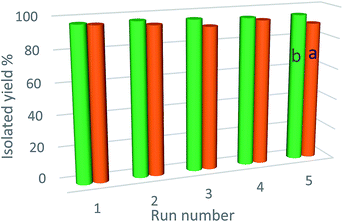 | ||
| Fig. 8 Recyclability of Pd(0)–SMTU–boehmite in the coupling of iodobenzene with phenylboronic acid (a) and the coupling of 4-iodotoluene with butyl acrylate (b). | ||
In order to show the structural stability of the catalyst after recycling, the recovered catalyst was characterized using FT-IR and XRD techniques. The recovered catalyst was investigated using XRD (Fig. 9) and FT-IR (Fig. 10). The FT-IR spectrum and XRD pattern of the recovered Pd(0)–SMTU–boehmite indicate that this catalyst can be recycled without any change in its structure.
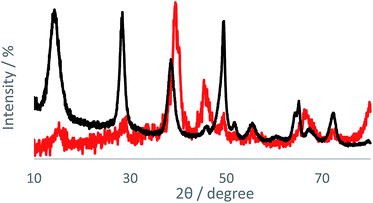 | ||
| Fig. 9 The XRD pattern of boehmite nanoparticles (black line) and the Pd(0)–SMTU–boehmite after 10 runs of recycling (red line). | ||
3 Conclusions
In summary, a novel type of boehmite, recoverable nanocatalyst (Pd(0)–SMTU–boehmite) was synthesized from the immobilization of Pd nanoparticles on functionalized boehmite nanoparticles. This catalyst showed excellent catalytic activity, high reusability and air or moisture stability for Heck and Suzuki reactions in water or PEG-400. The advantages of this protocol are the use of commercially available, eco-friendly, cheap and chemically stable materials, the operational simplicity, its practicability, and good to high yields. More importantly, the catalyst can be synthesized readily from inexpensive and commercially available starting materials. Also, nano-boehmite is a new support for the heterogenization of homogeneous catalysts, which was prepared using a very simple procedure in water at room temperature using commercially available materials. The catalyst can be reused 5 times without Pd leaching or any significant loss of its activity.4 Experimental
4.1 Materials
Chemicals and solvents used in this work were obtained from Sigma-Aldrich, Fluka or Merck chemical companies and used without further purification. Boehmite nanoparticles and Pd–SMTU–boehmite were identified using a Holland Philips X’pert X-ray powder diffraction (XRD) diffractometer, at a scanning speed of 2° min−1 from 2° to 80°. Thermogravimetric analysis (TGA) of the samples was performed using a Shimadzu PL-STA 1500 device in the temperature range of 30–800 °C. The particle size and morphology were examined using SEM with a FESEM-TESCAN MIRA3, at an accelerating voltage of 30.0 kV, and also using TEM with a Zeiss-EM10C transmission electron microscope. Nitrogen adsorption/desorption isotherms were recorded at 120 °C with a Brunauer Emmett Teller Analysis Adsorption BELSORP Mini II. IR spectra were recorded as KBr pellets on a VRTEX 70 model BRUKER FT-IR spectrophotometer. The content of Pd was measured using inductively coupled plasma-optical emission spectrometry (ICP-OES). 1H NMR spectra were recorded with a Bruker DRX-400 spectrometer at 400 MHz. Melting points were measured with an Electrothermal 9100 apparatus.4.2 Preparation of the catalyst
A solution of NaOH (6.490 g) in 50 mL of distilled water was added to a solution of Al(NO3)3·9H2O (20 g) in 30 mL distilled water, drop by drop under vigorous stirring. The resulting milky mixture was subjected to mixing in an ultrasonic bath for 3 h at 25 °C. The resulting nano-boehmite was filtered, washed using distilled water and kept in an oven at 220 °C for 4 h. The obtained boehmite nanoparticles (1.5 g) were dispersed in 50 mL of toluene using sonication for 30 min, and then 2.5 mL of (3-choloropropyl)triethoxysilane (CPTES) was added to the mixture. The reaction mixture was stirred at 40 °C for 8 h. Then, the prepared nanoparticles (nPr–Cl–boehmite) were filtered, washed with ethanol and dried at room temperature. The obtained nPr–Cl–boehmite (1 g) was dispersed in 50 mL of ethanol for 20 min, and then a S-methylisothiourea hemisulfate salt (2.5 mmol) and potassium carbonate (2.5 mmol) were added to the reaction mixture and stirred for 18 h at 80 °C. Then, the resulting nanoparticles (SMTU–boehmite) were filtered, washed with ethanol and dried at room temperature. TGA was used to determine the percentage of chemisorbed organic functional groups on the boehmite nanoparticles. The obtained SMTU–boehmite (0.5 g) was dispersed in 25 mL of ethanol using sonication for 20 min, and then palladium acetate (0.25 g) was added to the reaction mixture. The reaction mixture was stirred at 80 °C for 20 h. Then, NaBH4 (0.3 mmol) was added to the reaction mixture and stirred for 2 hours. The final product (Pd(0)–SMTU–boehmite) was filtered, washed using ethanol and dried at room temperature. The amount of palladium was determined using EDS and ICP-OES analysis.4.3 Results of catalyst characterization
IR (KBr) cm−1: 3384, 3098, 2101, 1631, 1568, 1418, 1111, 739, 692, 624, 480; ICP-OES (amount of Pd) mol g−1: 2.55 × 10−3; BET (at 120 °C for 3 h): as,BET = 82.90 m2 g−1, Vp = 0.19 cm3 g−1, rp = 1.21 nm; XRD (2θ/degree) at: 14.40, 28.41, 38.55, 39, 46, 46.45, 49.55, 51.94, 56.02, 59.35, 65.04, 65.56, 67, 68.09, and 72.38.4.4 General procedure for the Suzuki reaction
A mixture of an aryl halide (1 mmol), phenylboronic acid (1 mmol) or 3,4-difluorophenylboronic acid (1 mmol), Na2CO3 (1.5 mmol), and Pd(0)–SMTU–boehmite (0.005 g, 0.8 mol%) was added to a reaction vessel. The resulting mixture was stirred in H2O at room temperature and the progress of the reaction was monitored using TLC. After completion of the reaction, the catalyst was separated and washed with ethyl acetate. The reaction mixture was extracted with H2O and ethyl acetate, and the organic layer dried over anhydrous Na2SO4 (1.5 g). Then the solvent was evaporated and pure biphenyl derivatives were obtained in good to excellent yields.4.5 General procedure for the Heck reaction
A mixture of an aryl halide (1 mmol), an alkene (1.2 mmol), Na2CO3 (1.5 mmol), and Pd(0)–SMTU–boehmite (0.016 g, 2.56 mol%) was stirred in PEG-400 at 120 °C (progress of the reaction was monitored using TLC). After completion of the reaction, the mixture was cooled to room temperature and then catalyst was separated and washed with diethyl ether. The reaction mixture was extracted with H2O and diethyl ether. The organic layer was dried over Na2SO4 (1.5 g) and the solvent evaporated to obtain pure products in 85–99% yield.4.6 Selected spectral data
Acknowledgements
This work was supported by the research facilities of Ilam University, Ilam, Iran.References
- A. Islama, E. S. Chanc, Y. H. Taufiq-Yapa, S. H. Teoa and M. A. Hoque, Ceram. Int., 2014, 40, 3779 CrossRef.
- B. Xu, J. Wang, H. Yu and H. Gao, J. Environ. Sci., 2011, 23, S49 CrossRef.
- A. Ghorbani-Choghamarani and B. Tahmasbi, New J. Chem., 2016, 40, 1205 RSC.
- L. Rajabi and A. A. Derakhshan, Sci. Adv. Mater., 2010, 2, 163 CrossRef CAS.
- N. V. Garderen, F. J. Clemens, C. G. Aneziris and T. Graule, Ceram. Int., 2012, 38, 5481 CrossRef.
- F. Granados-Correa and J. Jimenez-Becerril, J. Hazard. Mater., 2009, 162, 1178 CrossRef CAS PubMed.
- M. B. Gholivanda, G. Malekzadehb and A. A. Derakhshan, Sens. Actuators, B, 2014, 201, 378 CrossRef.
- Y. Zheng, S. Ji, H. Liu, M. Li and H. Yang, Particuology, 2012, 10, 751 CrossRef CAS.
- X. Y. Chen, H. S. Huh and S. W. Lee, Nanotechnology, 2007, 18, 285608 CrossRef.
- S. M. Kim, Y. J. Lee, K. W. Jun, J. Y. Park and H. S. Potdar, Mater. Chem. Phys., 2007, 104, 56 CrossRef CAS.
- M. Thiruchitrambalam, V. R. Palkar and V. Gopinathan, Mater. Lett., 2004, 58, 3063 CrossRef CAS.
- A. Ghorbani-Choghamarani, B. Tahmasbi, F. Arghand and S. Faryadi, RSC Adv., 2015, 5, 92174 RSC.
- M. Mirzaee, B. Bahramian and A. Amoli, Appl. Organomet. Chem., 2015, 29, 593 CrossRef CAS.
- K. Bahrami, M. M. Khodaei and M. Roostaei, New J. Chem., 2014, 38, 5515 RSC.
- S. M. Islam, A. S. Roy, P. Mondal and N. Salam, Appl. Organomet. Chem., 2012, 26, 625 CrossRef CAS.
- S. Pasa, Y. S. Ocak, H. Temel and T. Kilicoglu, Inorg. Chim. Acta, 2013, 405, 493 CrossRef CAS.
- A. Ghorbani-Choghamarani and H. Rabiei, Tetrahedron Lett., 2016, 57, 159 CrossRef CAS.
- S. Nadri, M. Joshaghani and E. Rafiee, Appl. Catal., A, 2009, 362, 163 CrossRef CAS.
- A. R. Hajipour and F. Rafiee, J. Iran. Chem. Soc., 2015, 12, 1177 CrossRef CAS.
- H. Liu, J. Deng and W. Li, Catal. Lett., 2010, 137, 261 CrossRef CAS.
- A. Ghorbani-Choghamarani, B. Tahmasbi and P. Moradi, Appl. Organomet. Chem., 2016 DOI:10.1002/aoc.3449.
- N. Shang, S. Gao, C. Feng, H. Zhang, C. Wang and Z. Wang, RSC Adv., 2013, 3, 21863 RSC.
- W. Chen, L. X. Zhong, X. W. Peng, K. Wang, Z. F. Chen and R. C. Sun, Catal. Sci. Technol., 2014, 4, 1426 CAS.
- M. Ma, Q. Zhang, D. Yin, J. Dou, H. Zhang and H. Xu, Catal. Commun., 2012, 17, 168 CrossRef CAS.
- M. Hajjami and B. Tahmasbi, RSC Adv., 2015, 5, 59194 RSC.
- F. Havasi, A. Ghorbani-Choghamarani and F. Nikpour, Microporous Mesoporous Mater., 2016, 224, 26 CrossRef CAS.
- A. Ghorbani-Choghamarani, Z. Darvishnejad and B. Tahmasbi, Inorg. Chim. Acta, 2015, 435, 223 CrossRef CAS.
- S. Rostamnia, E. Doustkhah and B. Zeynizadeh, Microporous Mesoporous Mater., 2016, 222, 87 CrossRef CAS.
- H. B. Wang, Y. H. Zhang, H. L. Yang, Z. Y. Ma, F. W. Zhang, J. Sun and J. T. Ma, Microporous Mesoporous Mater., 2013, 168, 65 CrossRef CAS.
- T. Chen, J. Gao and M. Shi, Tetrahedron, 2006, 62, 6289 CrossRef CAS.
- M. Nasrollahzadeh, S. M. Sajadi and M. Maham, J. Mol. Catal. A: Chem., 2015, 396, 297 CrossRef CAS.
- V. W. Faria, D. G. M. Oliveira, M. H. S. Kurz, F. F. Goncalves, C. W. Scheeren and G. R. Rosa, RSC Adv., 2014, 4, 13446 RSC.
- S. J. Sabounchei and A. Hashemi, Inorg. Chem. Commun., 2014, 47, 123 CrossRef CAS.
- M. Nasrollahzadeh, A. Azarian, M. Maham and A. Ehsani, J. Ind. Eng. Chem., 2015, 21, 746 CrossRef CAS.
- A. Modak, J. Mondal, M. Sasidharan and A. Bhaumik, Green Chem., 2011, 13, 1317 RSC.
- S. Singha, M. Sahoo and K. M. Parida, Dalton Trans., 2011, 40, 7130 RSC.
- H. A. Patel, A. L. Patel and A. V. Bedekar, Appl. Organomet. Chem., 2015, 29, 1 CrossRef CAS.
- F. Alonso, I. P. Beletskaya and M. Yus, Tetrahedron, 2008, 64, 3047 CrossRef CAS.
- H. Veisi, R. Ghorbani-Vaghei, S. Hemmati, M. Haji Aliani and T. Ozturk, Appl. Organomet. Chem., 2015, 29, 26 CrossRef CAS.
- F. Alonso, I. P. Beletskaya and M. Yus, Tetrahedron, 2005, 61, 11771 CrossRef CAS.
- S. J. Sabounchei and M. Ahmadi, Inorg. Chim. Acta, 2013, 405, 15 CrossRef CAS.
- M. L. Kantam, P. V. Redddy, P. Srinivas, A. Venugopal, S. Bhargava and Y. Nishina, Catal. Sci. Technol., 2013, 3, 2550 CAS.
| This journal is © The Royal Society of Chemistry 2016 |

